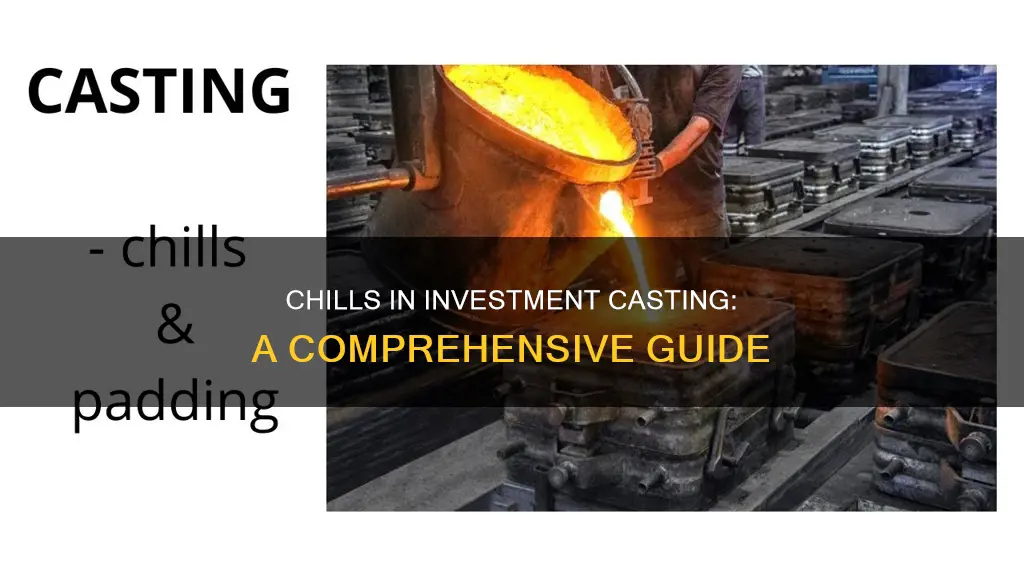
Investment casting is a manufacturing process that produces precise components while minimising material waste, energy usage and subsequent machining. It can also ensure the production of intricate parts, making it a useful process for design engineers. Chills are an important part of the investment casting process. They are metal inserts used to promote directional solidification and uniform cooling of the casting. They are placed inside the mould cavity and can be divided into two types: internal and external chills. Internal chills are placed inside the mould cavity and eventually melt and become part of the casting, so they must be made of the same material. External chills are placed on the surface of the mould and can be recycled and reused. Chills are used to increase the local cooling rate of the casting and are placed in conjunction with the gating and riser systems to control the solidification sequence and increase the feeding distance of the riser.
| Characteristics | Values |
|---|---|
| Definition | An object used to promote solidification in a specific portion of a metal casting mold |
| Types | Internal chills, external chills |
| Placement | Internal chills are placed inside the mould cavity; external chills are placed against the wall |
| Composition | Iron, steel, copper, aluminium, bronze, carbide, graphite, silicon carbide, zircon sand, chromite sand, etc. |
| Function | Promote directional solidification, uniform cooling, and reduce defects |
| Application | Useful when casting thickness is uneven, and to reduce shrinkage and porosity defects |
What You'll Learn

How internal chills are placed inside the mould cavity
Investment casting is a process that produces precise components while minimising material waste, energy, and subsequent machining. It is often used to create intricate parts, making it a useful process for design engineers.
Chills are an important part of the investment casting process. They are objects used to promote solidification in a specific portion of a metal casting mould. They are placed inside the mould cavity to increase the local cooling rate of the casting. Chills are divided into two types: internal and external.
Internal chills are pieces of metal that are placed inside the mould cavity. They are strategically placed to promote directional solidification and uniform cooling of the casting. When the molten metal comes into contact with the solid chills, they start to melt, providing progressive directional solidification. This process helps to reduce hot spots and shrinkage defects, as well as improving the mechanical properties of the casting.
It is important to note that internal chills will eventually become part of the casting, so they must be made of the same material as the casting. The volume, shape, and size of the chills should be sufficient to cool the molten metal at the required rate. They should be placed away from the in-gate to avoid turbulence in the mould and should be vertically positioned. Additionally, internal chills should be free from moisture, dirt, oil, and grease to avoid defects in the casting.
Overall, the use of internal chills in investment casting is a crucial technique to ensure the successful production of precise and intricate components.
Renovation: An Investment Activity in Cash Flow Statements?
You may want to see also

How external chills are placed against the mould wall
External chills are placed against the mould wall in investment casting to promote directional solidification and uniform cooling of the casting. They are masses of material with high heat capacity and thermal conductivity, placed on the edge of the moulding cavity, becoming part of the cavity wall.
External chills are placed against the mould wall by first being formed from materials such as iron, copper, bronze, aluminium, graphite, silicon carbide, zircon sand, or chromite sand. These materials are formed into metal chill blocks, which are then placed on the surface of the mould pattern or core box. This strategic placement allows the external chill to increase the feeding distance of a riser or reduce the number of risers required.
The use of external chills in investment casting provides several advantages. Firstly, they can be recycled and reused, making them a cost-effective option. Secondly, they help improve the quality of the casting by reducing cavities and shrinkage defects. External chills also increase the heat-extraction capacity of the mould, providing a steeper temperature gradient. This results in a higher cooling rate, eliminating hotspots and shrinkage defects, especially in thick sections of the casting.
It is important to note that the placement of external chills should be carefully considered. They should be placed away from the in-gate to avoid turbulence in the mould and should have smooth curves instead of sharp angles to ensure optimal performance in the investment casting process.
Acorn App: Investing Made Easy for Beginners
You may want to see also

The role of chills in reducing casting defects
Chills are an essential aspect of investment casting, playing a crucial role in reducing casting defects and improving the overall quality of the final product. They are strategically placed within the mould to promote directional solidification and uniform cooling, which are critical in obtaining qualified castings. This process involves two types of chills: internal and external, each serving distinct purposes and contributing to the reduction of casting defects in unique ways.
Internal chills are metal pieces placed inside the mould cavity, melting and becoming an integral part of the final casting. As such, it is imperative that internal chills are composed of the same material as the casting. By absorbing both heat capacity and heat of fusion energy, internal chills help regulate the solidification process and ensure a uniform cooling rate. This is particularly beneficial in preventing shrinkage defects and porosity issues that can arise due to uneven cooling in castings with varying thicknesses.
On the other hand, external chills are positioned on the edge of the mould cavity, effectively becoming an extension of the cavity wall. These chills are made from materials with high heat capacity and thermal conductivity, such as cast iron, steel, copper, or aluminium. External chills are not incorporated into the final casting but can be recycled and reused, making them a sustainable option. They are instrumental in reducing the number of risers required and increasing the feeding distance of the riser, thereby minimising the occurrence of defects associated with risers.
The strategic placement of chills in investment casting is a nuanced process that considers various factors. These factors include the sections of the casting to be chilled, the temperature of the molten metal, the desired solidification rate, the dimensions and complexity of the casting, and the type of material used for casting. By optimising the position and composition of chills, casting defects such as porosity, shrinkage, and cracks can be significantly reduced or eliminated.
Moreover, chills offer the advantage of reducing hot spots, especially in castings with interconnected sections like T-sections, X-sections, and L-sections. This reduction in hot spots helps prevent overheating and ensures a more uniform temperature distribution within the mould. Additionally, chills can enhance the mechanical properties of the casting by refining the grain structure and improving hardness, ductility, and strength.
Unlocking EPF for ASB Investment: A Guide
You may want to see also

The advantages and disadvantages of using chills
Chills are objects used to promote solidification in specific areas of a metal casting mould. They are used to control the solidification sequence of the castings to obtain qualified castings.
There are two types of chills: internal and external. Internal chills are placed inside the moulding cavity and eventually become part of the casting, so they must be made of the same material. External chills are placed on the edge of the moulding cavity and can be recycled and reused.
Advantages of Using Chills
Internal chills can be used to:
- Speed up the local cooling rate of the casting
- Reduce the size of the riser and increase the qualified rate
- Improve the feeding channel
- Increase the feeding distance of the riser
- Eliminate local thermal stress and prevent cracks
- Accelerate the solidification rate of the casting
- Refine the grain structure
- Improve the mechanical properties of the casting
External chills can be used to:
- Increase the feeding distance of a riser
- Reduce the number of risers required
Disadvantages of Using Chills
There are no clear disadvantages to using chills outlined in the sources. However, the process of investment casting is complex and involves many steps, making it relatively expensive.
Strategies for Investing Cash Reserves: A Guide to Opportunities
You may want to see also

The factors that determine the use of chills
Chills are an important aspect of investment casting, helping to promote solidification and uniform cooling of the casting. The decision to use chills and the type of chills employed depend on several factors, including the desired outcome, the geometry of the mould, and the material being cast.
The first factor is the desired outcome. Chills are used to increase the heat-extraction capacity of the mould, providing a steeper temperature gradient. This helps to reduce defects in the final product, such as cavities, shrinkage, and porosity. Chills can also be used to increase the qualified rate of final metal castings, improve the internal quality level of castings, and reduce the number of risers required.
The second factor is the geometry of the mould. Chills are used when the geometry of the mould cavity prevents directional solidification from occurring naturally. In such cases, chills can be strategically placed to promote directional solidification and control the solidification sequence. Chills can also be used to increase the feeding distance of a riser, which is particularly beneficial in areas where it is difficult to install risers.
The third factor is the material being cast. The type of material used for casting will determine the type of chill that can be used. For example, when casting aluminium alloy, the slow solidification rate can result in the formation of pinholes. Chills can be used to increase the solidification rate, reducing the pinhole degree in the final casting. Additionally, the material used for the chill must be compatible with the casting material. For internal chills, this means using the same material as the casting, as they will become part of the final product. External chills, on the other hand, can be made from a range of materials with high heat capacity and thermal conductivity, such as cast iron, steel, copper, or aluminium.
In conclusion, the use of chills in investment casting is determined by the desired outcome, the geometry of the mould, and the material being cast. Chills play a crucial role in promoting solidification, controlling cooling rates, and reducing defects in the final product.
Morris Invest: The Cash-Only Strategy Explained
You may want to see also







